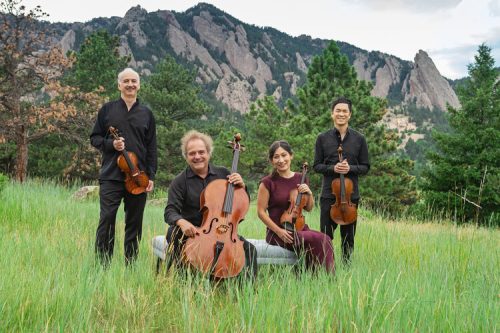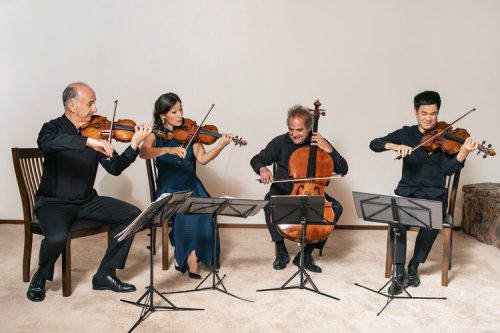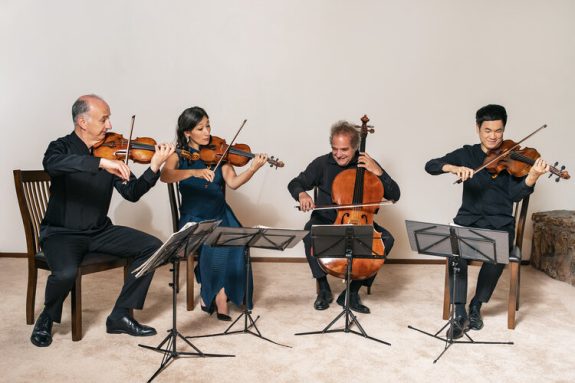 United Kingdom Haydn, Janáček, Beethoven: Takács Quartet (Edward Dusinberre, Harumi Rhodes [violins], Richard O’Neill [viola] and András Fejér [cello]), Wigmore Hall, London, 8.11.2021. (CS)
United Kingdom Haydn, Janáček, Beethoven: Takács Quartet (Edward Dusinberre, Harumi Rhodes [violins], Richard O’Neill [viola] and András Fejér [cello]), Wigmore Hall, London, 8.11.2021. (CS)

Haydn – String Quartet in F minor, Op.20 No.5
Janáček – String Quartet No.2, ‘Intimate Letters’
Beethoven – String Quartet No.15 in A minor, Op.132
Four years is a long time in the life of a String Quartet. Preparing to attend this Wigmore Hall recital by the Takács Quartet, I realised that it was in 2017 that I had last heard the ensemble perform live, and on that occasion Károly Schranz had been seated in the second violinist’s chair, alongside leader Edward Dusinberre, with viola player Geraldine Walther and cellist András Fejér completing the ensemble. There has been considerable change since then. Harumi Rhodes replaced Schranz in 2018 and last year, upon Walther’s retirement, viola player Richard O’Neill joined the Quartet. Fejér is now the only original member of the Quartet which was founded in 1975. This recital was the first opportunity to hear the new line-up perform in the UK.
In many ways, the impression was that little has changed. The distinctive individual musicianship still coheres into a unified ensemble aesthetic, the playing is technically flawless, and that wonderful ‘breadth’ that a Takács performance often seems to possess was still in evidence, most particularly here in Beethoven’s Op.132 Quartet. But, it seemed to me that the quartet’s musical personality was not stamped on their performance here with quite the same certainty and ease, that there were fewer risks taken, and that, while each of the players made a committed, eloquent contribution, it fell to disproportionately to Dusinberre to provide direction – something that I do not recall from previous performances by the Takács that I have enjoyed.
The Takács frequently tackle repertoire that is off-the-beaten track and work with contemporary composers. Their recording, with pianist Garrick Ohlsson of piano quintets by Edward Elgar and Amy Beach won the 2021 Gramophone Award for chamber recordings, and this 2021-22 season will see the Quartet collaborate with bandoneon/accordion virtuoso Julien Labro, performing new works composed for them by Clarice Assad and Bryce Dessner. They will also give the world premiere of a new quartet by Stephen Hough, Les Six Rencontres, which the Takács will then record alongside quartets by Ravel and Dutilleux, for Hyperion. At Wigmore Hall, though, it was back to the canon – for Janáček’s two string quartets are surely now firmly housed at the core of the repertoire, and the second of them, ‘Intimate Letters’, was here framed by representatives of the Classical tradition.

Haydn’s Op.20 Quartets, a set of six which the composer aptly nicknamed the ‘Sun’ Quartets, are often considered the dawn of the string quartet. Composed in 1772, these quartets present strikingly contrasting material and moods but share qualities such as diverse textures, with the four voices treated more equally than in Haydn’s earliest quartets, and continuous motivic articulation and development. The Op.20 also stray more frequently into the minor mode, and in the case of two of the set it is the home key: No.3 in G minor and, the quartet we heard here, No.5 in F minor.
The F minor Quartet is notable for the sophistication and variety with which Haydn develops the sonata principle within each of its movements, and this generates a sense of ongoing drama which the Takács conjured immediately in the Allegro moderato, introducing the opening subject with quiet intensity, and making much of the dynamic contrasts and almost abrasive interjections. There was a strong sense of pushing forward, but not of haste, and of a culmination of the complexly developed material in the searching coda, in which the textures were energised by vigorous bow strokes. The Menuetto and Trio felt ‘substantial’, its solemnity alleviated by graceful details such as arching arpeggio motifs in the cello, which provided ‘lift’, and finely graded crescendos and diminuendos which provided shapeliness to both individual phrases and the overall structure. Dusinberre sang sweetly in the Adagio above a gently lilting accompaniment which was not too staccato, allowing a hint of ‘vulnerability’ to be felt within the theme’s tenderness before the expansion of the texture brought comfort and warmth. It was the final fugue, though, that provided most interpretative interest. The pianissimo counterpoint was fidgety but nimble, the delicacy intermittently blown away by sudden explosions of vigour, even violence, creating a rewarding sense of release.
Such restlessness and sometimes alarming contrasts are essential qualities of Janáček’s Second Quartet but here I found the playing of the Takács Quartet a little too suave. It is not that they did not sculpt the varied motifs, which seem to tumble after one another in an almost arbitrary fashion, and eccentric textures with precise character and timbre – rather, that it all sounded a bit too accomplished. Of course, there is an essential paradox within this music: it seems to convey spontaneous outbursts of raw emotion, feelings that cannot be anticipated nor withheld, alongside passages of intimate reflection and interiority, but such extremes and waywardness demand absolute technical control if they are to be communicated and understood. How to balance passion and emotional disturbance with calm technical discipline? It is a question that I am not sure the quartet answered here: at times I wanted a bit more grit and rasp, for the mosaic structures to sound more ‘fraught’, and thus for the melodic climaxes to be charged with a tremendous sense of release.
There was much to admire, however, not least the precision with which Dusinberre and Rhodes matched stroke and tone, and the bloom of O’Neill’s viola themes. The way that the second movement gradually acquired momentum, as if infected by an ever more pressing, even spiky, dance was persuasive, and in the Largamente section of the third movement, the beautiful tone of Dusinberre’s high E string above the airy lucidity of the lower strings was like a light-beam, easing the preceding shadows. I would have liked a more vicious stamp, a wilder lurch, in the final movement, but there was a compelling vigour in the closing episodes which conjured excitement and passion.
The understated command of the Takács Quartet also characterised their approach to Beethoven’s Op.132 but the refinement of their playing did not always serve to communicate the expansive dimensions and weight of this Quartet, nor its darkness, which is felt from the first austere cello motif which initiates the opening movement. A more melancholy tenor would have set off the lightness of the Scherzo more dramatically. In the latter, the playing was urbane and clean – rhythms neat, hemiolas coy, motifs exchanged courteously – and the Trio introduced a note of freshness and freedom. The great ‘Heiliger Dankgesang’ Molto adagio benefited from the ability of the quartet to sculpt long lines and sustain a quiet intensity. The playing was calm, with restrained vibrato, but still noble, but the movement did not seem to me to reach the heights of sublimity, lacking a certain searching quality especially in those moments when the light is let into through the cathedral window. In the Alla marcia there was plenty of air between bow and string, opening up a space for the first violin’s headlong rush into the Allegro appassionato which, again, was refined rather than bold, distinguished rather than daring.
One could not complain about the Takács Quartet’s consummate command, but overall it felt as if this foursome hadn’t yet quite found their ensemble-feet.
Claire Seymour
